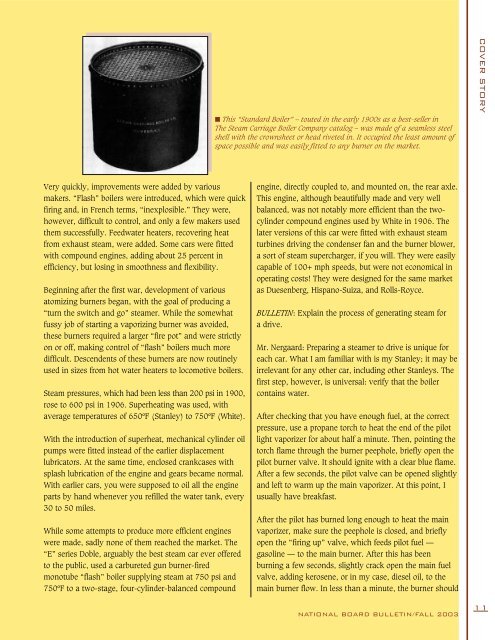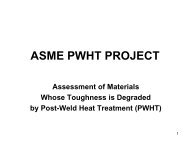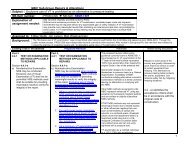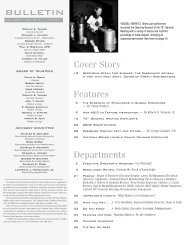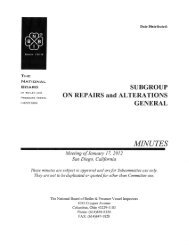bulletin - The National Board of Boiler and Pressure Vessel Inspectors
bulletin - The National Board of Boiler and Pressure Vessel Inspectors
bulletin - The National Board of Boiler and Pressure Vessel Inspectors
Create successful ePaper yourself
Turn your PDF publications into a flip-book with our unique Google optimized e-Paper software.
Very quickly, improvements were added by various<br />
makers. “Flash” boilers were introduced, which were quick<br />
firing <strong>and</strong>, in French terms, “inexplosible.” <strong>The</strong>y were,<br />
however, difficult to control, <strong>and</strong> only a few makers used<br />
them successfully. Feedwater heaters, recovering heat<br />
from exhaust steam, were added. Some cars were fitted<br />
with compound engines, adding about 25 percent in<br />
efficiency, but losing in smoothness <strong>and</strong> flexibility.<br />
Beginning after the first war, development <strong>of</strong> various<br />
atomizing burners began, with the goal <strong>of</strong> producing a<br />
“turn the switch <strong>and</strong> go” steamer. While the somewhat<br />
fussy job <strong>of</strong> starting a vaporizing burner was avoided,<br />
these burners required a larger “fire pot” <strong>and</strong> were strictly<br />
on or <strong>of</strong>f, making control <strong>of</strong> “flash” boilers much more<br />
difficult. Descendents <strong>of</strong> these burners are now routinely<br />
used in sizes from hot water heaters to locomotive boilers.<br />
Steam pressures, which had been less than 200 psi in 1900,<br />
rose to 600 psi in 1906. Superheating was used, with<br />
average temperatures <strong>of</strong> 650ºF (Stanley) to 750ºF (White).<br />
With the introduction <strong>of</strong> superheat, mechanical cylinder oil<br />
pumps were fitted instead <strong>of</strong> the earlier displacement<br />
lubricators. At the same time, enclosed crankcases with<br />
splash lubrication <strong>of</strong> the engine <strong>and</strong> gears became normal.<br />
With earlier cars, you were supposed to oil all the engine<br />
parts by h<strong>and</strong> whenever you refilled the water tank, every<br />
30 to 50 miles.<br />
While some attempts to produce more efficient engines<br />
were made, sadly none <strong>of</strong> them reached the market. <strong>The</strong><br />
“E” series Doble, arguably the best steam car ever <strong>of</strong>fered<br />
to the public, used a carbureted gun burner-fired<br />
monotube “flash” boiler supplying steam at 750 psi <strong>and</strong><br />
750ºF to a two-stage, four-cylinder-balanced compound<br />
■ This “St<strong>and</strong>ard <strong>Boiler</strong>” – touted in the early 1900s as a best-seller in<br />
<strong>The</strong> Steam Carriage <strong>Boiler</strong> Company catalog – was made <strong>of</strong> a seamless steel<br />
shell with the crownsheet or head riveted in. It occupied the least amount <strong>of</strong><br />
space possible <strong>and</strong> was easily fitted to any burner on the market.<br />
engine, directly coupled to, <strong>and</strong> mounted on, the rear axle.<br />
This engine, although beautifully made <strong>and</strong> very well<br />
balanced, was not notably more efficient than the twocylinder<br />
compound engines used by White in 1906. <strong>The</strong><br />
later versions <strong>of</strong> this car were fitted with exhaust steam<br />
turbines driving the condenser fan <strong>and</strong> the burner blower,<br />
a sort <strong>of</strong> steam supercharger, if you will. <strong>The</strong>y were easily<br />
capable <strong>of</strong> 100+ mph speeds, but were not economical in<br />
operating costs! <strong>The</strong>y were designed for the same market<br />
as Duesenberg, Hispano-Suiza, <strong>and</strong> Rolls-Royce.<br />
BULLETIN: Explain the process <strong>of</strong> generating steam for<br />
a drive.<br />
Mr. Nergaard: Preparing a steamer to drive is unique for<br />
each car. What I am familiar with is my Stanley; it may be<br />
irrelevant for any other car, including other Stanleys. <strong>The</strong><br />
first step, however, is universal: verify that the boiler<br />
contains water.<br />
After checking that you have enough fuel, at the correct<br />
pressure, use a propane torch to heat the end <strong>of</strong> the pilot<br />
light vaporizer for about half a minute. <strong>The</strong>n, pointing the<br />
torch flame through the burner peephole, briefly open the<br />
pilot burner valve. It should ignite with a clear blue flame.<br />
After a few seconds, the pilot valve can be opened slightly<br />
<strong>and</strong> left to warm up the main vaporizer. At this point, I<br />
usually have breakfast.<br />
After the pilot has burned long enough to heat the main<br />
vaporizer, make sure the peephole is closed, <strong>and</strong> briefly<br />
open the “firing up” valve, which feeds pilot fuel —<br />
gasoline — to the main burner. After this has been<br />
burning a few seconds, slightly crack open the main fuel<br />
valve, adding kerosene, or in my case, diesel oil, to the<br />
main burner flow. In less than a minute, the burner should<br />
NATIONAL BOARD BULLETIN/FALL 2003<br />
COVER STORY<br />
11


